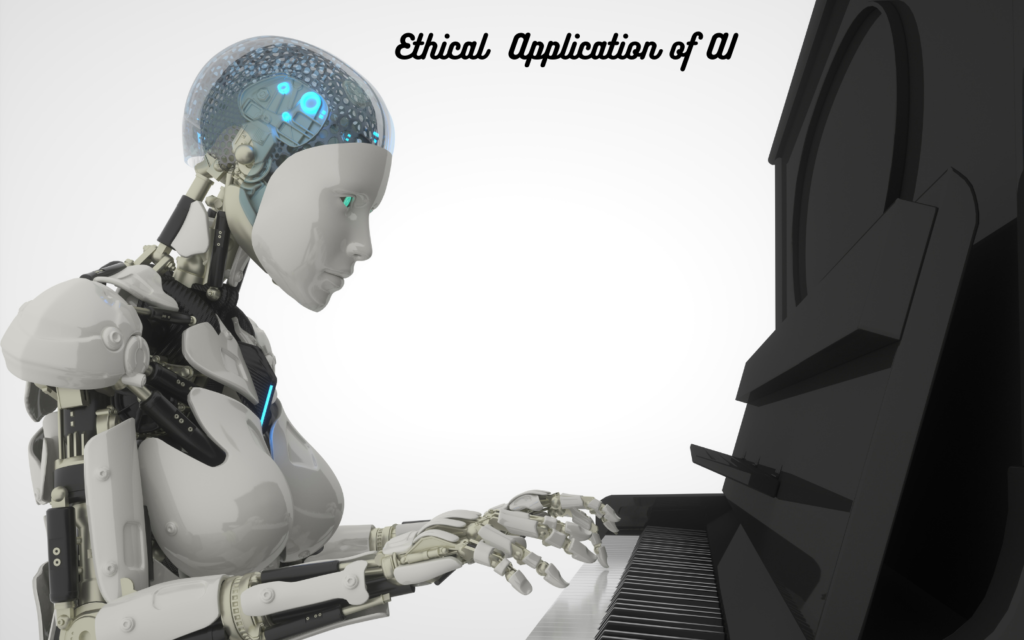Introduction: "Ethical AI: Shaping the Future Responsibly"

In the fast-evolving world of artificial intelligence (AI), ethical AI use is crucial. AI systems influence healthcare, banking, and autonomous transportation, thus their research and implementation must be moral. The “ethical application of AI” ensures that AI technologies are conceived, implemented, and managed to respect human rights, promote fairness, increase transparency, maximize society and individual advantages, and minimize harm.
Data privacy, algorithmic bias, and socio-economic disruption must be considered while implementing ethical AI. Developers, policymakers, and users must stay aware of ethical developments and examine and integrate ethical considerations throughout AI system lifecycles. By designing AI developments responsibly, we may maximize their potential while ensuring they serve the common good and improve human capacities without compromising dignity or equity.
This method builds stakeholder trust and protects against AI’s unforeseen repercussions, enabling sustainable, inclusive, and transparent technological growth. “Ethical AI: Shaping the Future Responsibly” explores these subjects, emphasizing the importance of ethics in current AI and the need for collaboration to apply principles.
Table of Contents
Definition of Ethical AI:
Ethical AI integrates morality and values into AI technology design and deployment to improve society. This idea underpins the “Ethical Application of AI,” which holds that all AI operations, practices, and tactics must prevent damage and benefit society.
Foundation of Ethical AI:
Ethical AI is based on the necessity to build these technologies with a comprehensive knowledge of their social, ethical, and legal ramifications. It’s not enough to make AI lawful; it must also promote equality, fairness, justice, and privacy.
Operationalizing Ethical Principles:
Integrating ethics into AI requires turning abstract ethical concepts into tangible practices and algorithms. This requires ethical considerations in algorithm construction, data selection and treatment, and AI system decision-making.
Promoting Positive Impact:
AI should advance society, boost human welfare, and support democracy and human rights. Ethical AI requires proactive measures to eliminate biases, prejudice, and other undesirable results from unregulated AI systems.
Stakeholder Involvement:
Ethical AI involves collaboration between ethicists, sociologists, legal experts, AI researchers, and the public. This ensures a holistic approach to understanding and anticipating AI technologies and infusing deep-seated values into their functionality.
Continuous Evaluation and Adaptation:
AI technologies and applications should change, so should their ethical frameworks. Analysis, feedback, and adaptation are needed to solve emerging ethical issues and guarantee AI contributes to a just and equitable society.
The “Ethical Application of AI” goes beyond compliance with legislation to match AI technology with society’s values and morals throughout their functioning. This technique reduces risks and builds AI application trust and reliability.
Importance of Ethical Standards:
AI ethics are essential to developing and applying AI technology to prevent harm, defend human rights, and assure fairness across diverse populations. Using these criteria under “Ethical Application of AI” assures that AI works efficiently, effectively, and fairly.
Preventing Harm:
Ethical principles assist build AI safety safeguards to minimize inadvertent damage. This includes building AI systems to prevent physical, psychological, and social harm from malfunctioning or misuse in autonomous vehicles, health diagnostics, and personal support gadgets.

Protecting Human Rights:
Ethical AI promotes human rights. Privacy, freedom from prejudice, and life and security are examples. Developers integrate these principles into AI systems to ensure that the technology respects human rights at all times, especially when managing data and making decisions that affect users.
Ensuring Fair Treatment:
Ethical criteria ensure that “Ethical applications of AI” do not perpetuate bias or lead to discriminatory consequences, assuring equitable treatment across all user demographics. This requires extensive algorithm testing and revision to identify and eradicate race, gender, age, and other socio-demographic biases. Social inclusion and equality in AI applications are essential for public trust and acceptance.
Cultural and Contextual Awareness:
AI must be sensitive to cultural and contextual differences between human societies due to ethical standards. AI systems can adapt to varied global contexts without violating cultural ethics and norms by following these guidelines.
Trust and Accountability:
AI developers and companies gain public trust by following ethical principles. These guidelines also establish accountability criteria for regulatory oversight and breach resolution.
Using ethical norms in AI development and implementation is about maximizing the benefits of AI technologies. Thus, the “Ethical Application of AI” guides AI technologies toward societal goals of well-being, fairness, and collective life quality.
Addressing Bias in Algorithms:
Identification and elimination of biases in AI algorithms is crucial to using AI for good and fostering equality rather than perpetuating social disparities and injustices. This notion underpins the “Ethical Application of AI,” which promotes technology that treat everyone equally.
Source of Bias:
Large datasets may contain historical or sociological biases that AI systems learn from. Biases can be accidentally encoded into algorithms, resulting in systematic disadvantages for particular populations. If demographic groups were underrepresented or poorly treated in prior recruiting statistics, a hiring tool based on that data may bias against them.
Impacts of Bias:
Biased AI can worsen social inequality without rigorous checks. Predictive policing systems may unfairly target certain communities, while credit scoring algorithms may deny loans to individuals based on biased data sets.
Strategies for Mitigation:
To reduce bias in AI algorithms, diverse and representative data collection, bias audits, and autonomous bias detection and correction are needed. Varied AI stakeholders can assist discover biases by providing varied perspectives.
Regulatory and Ethical Frameworks:
Strong regulatory and ethical frameworks can guide AI ethics. These frameworks should advise on bias reduction to make AI systems fair across applications.
Educating and Training:
AI practitioners must learn to recognize, identify, and correct biases. This involves bias algorithm ethics teaching and training in fairer machine learning methods.
Transparency and Accountability:
AI apps must disclose their decision-making processes and biases. This may involve making AI decision routes more understandable or forming independent entities to audit AI programs.
The “Ethical Application of AI” stresses the importance of monitoring AI development and implementation to avoid amplifying societal prejudices. It asks for developers, users, and regulatory bodies to collaborate to produce AI that is intelligent, equitable, and inclusive, paving the way for technology that benefits all.

Data Privacy and Security:
Highlighting personal data security and AI system data security is crucial to AI technology trustworthiness and efficacy. The “Ethical Application of AI,” which protects privacy and secrecy in AI interactions, requires these solutions.
Data Minimization:
Collecting and processing only the data needed for a lawful purpose—is a successful method. This strategy reduces data leaks and meets GDPR data privacy requirements.
Encryption and Anonymization:
Strong data encryption at rest and in transit protects personal data. Further security and privacy are added by anonymizing data so subjects cannot be identified.
Transparent Data Policies:
Clear and clear data policies are essential. These policies should explain what data is gathered, how it is used, who gets it, and how long it is kept. Data openness helps people make informed decisions and builds trust in AI systems.
Regular Audits and Compliance Checks:
Audits and compliance checks should be done regularly to protect AI data. These audits discover and mitigate AI system risks and ensure internal and external legal and regulatory compliance.
Adoption of Privacy Enhancing Technologies (PETs):
Differential privacy, which adds noise to aggregate data to protect individual privacy, and federated learning, which allows algorithms to be trained centrally without exchanging data, can improve in “Ethical application of AI” and its privacy safeguards.
User Control and Consent:
Data control is essential. This includes allowing users to give informed consent for data use and withdraw consent, access, and correct their data.
Impact Assessments:
Privacy and security impact evaluations before releasing new AI apps can help identify concerns and develop mitigating methods. Data integrity and breach prevention require this proactive approach.
Ethical Application of AI and its data privacy and security requires designing systems that respect user autonomy and promote a secure digital environment. AI developers and operators can use these principles to create powerful, efficient, safe, and privacy-respecting AI systems. These efforts are essential for AI technology’s socially acceptable progress.
Transparency and Explainability:
Ethical Application of AI and its application requires clear and intelligible AI systems. This principle emphasizes the need for AI technology to make decisions and explain them clearly. Transparency promotes trust, accountability, and user evaluation and questioning of AI judgments.
Understanding AI Decisions:
Complex algorithms like deep learning might make AI systems seem like “black boxes,” making decision-making opaque. Developers must create algorithms that humans can understand and comprehend to make these processes transparent and explain decisions.
Building Trust:
Transparency builds trust. Users trust and accept AI technologies better when they understand how it works. The widespread use and integration of AI technologies into daily life require this trust.
Regulatory Compliance:
Transparency of AI systems, especially the “Ethical Application of AI” is being mandated in several locations and industries. The EU’s General Data Protection Regulation (GDPR) allows people to request an explanation of an AI decision that affects them. Such regulations promote legal and ethical compliance.
Accountability in AI:
Transparent AI systems enable accountability. When AI judgments are traceable and understood, it’s easier to assign blame. In healthcare, banking, and law enforcement, AI decisions have major consequences, thus accountability is essential.
Enabling User Participation:
AI transparency and explainability empower users by enabling participatory checks and balances. Users can evaluate, query, or contest AI system decisions that affect them, ensuring ethical and social compliance.
Ethical Design Choices:
Developers can choose modeling methods depending on transparency. Choose models that provide more insight into their decision-making process over those that are less interpretable, depending on the application and impact.
Continuous Improvement:
Transparent systems enable constant scrutiny and critique, which is crucial for continued improvement. User feedback can improve AI systems, rectify faults, and improve performance while adhering to ethics.
The ethical application of AI requires that systems be efficient and transparent to users. Using AI technology responsibly and justly across all sectors of human effort requires transparency and understandability.
Accountability:
“Ethical application of AI” requires defining accountability for harm or errors caused by AI systems. Clear lines of accountability ensure that individuals or entities are held accountable for AI acts, enabling trust, transparency, and ethical AI development and deployment.

Identifying Responsible Parties:
Making AI systems accountable for harm requires a multifaceted strategy. This may comprise developers, data scientists, the organization deploying the AI, policymakers that control its use, and end-users who engage with it.
Legal and Regulatory Frameworks:
Ethical norms and legal frameworks help build AI responsibility. Product liability laws, data protection legislation, and industry-specific standards explain AI-related harm and error obligations and liabilities.
Ethical Oversight and Review:
Ethical oversight groups can advise on responsible AI development and deployment. These bodies ensure that “Ethical Application of AI” systems are ethical, transparent, and minimize harm to persons and society.
Risk Assessment and Mitigation:
Risk evaluations during AI development highlight potential hazards and errors. Developers can limit harm and increase system reliability by proactively addressing these risks and applying mitigation techniques.
Human-in-the-Loop Systems:
Human oversight of AI decision-making can ensure accountability. Human review or involvement can uncover errors, avoid harmful decisions, and provide accountability when AI fails.
Continuous Monitoring and Auditing:
Accountability requires ongoing monitoring and auditing of AI systems after deployment. These techniques identify flaws, biases, and unexpected results, enabling quick correction and improvement.
Learning from Errors:
Errors must be investigated in thorough post-mortems to determine what went wrong and why. Learning from past mistakes helps improve AI development and deployment accountability and prevent future concerns.
Transparency in Decision-Making:
Maintaining accountability requires transparency in AI decision-making. Users and stakeholders should be able to scrutinize and hold AI accountable by seeing how it works, what data it utilizes, and why.
The Ethical Application of AI promotes responsible innovation and the ethical use of AI technologies for society by clearly defining roles and responsibilities, implementing oversight mechanisms, and promoting transparency and accountability throughout AI development and deployment processes.
Regulatory and Ethical Frameworks:
International, national, and industrial policies impact AI ethics. To ensure ethical AI development, deployment, and use, these policies set requirements. To promote ethical AI practices, protect human rights, and mitigate AI threats, this regulatory framework is needed.
International Standards:
The UN, OECD, and UNESCO have set worldwide “Ethical Application of AI” and its development principles. These criteria promote human rights and society values by emphasizing AI system transparency, accountability, fairness, and inclusivity.
National Regulations:
Countries are creating and adopting their own AI ethics regulations. The EU’s General Data Protection Regulation (GDPR) addresses AI and data protection. China has established AI ethics and governance rules for “Ethical Application of AI” and its development and deployment.
Industry-Specific Standards:
Different industries have sector-specific AI ethics requirements. Healthcare has guidelines on AI-driven medical application patient data protection and confidentiality. To enhance openness and accountability, financial services may regulate AI use.
Ethics Boards and Committees:
Some organizations have separate ethics boards or committees to oversee AI programs and ensure ethical compliance. These organizations are essential in reviewing AI applications’ ethical implications, identifying hazards, and suggesting mitigation techniques to ensure responsible AI use
Ethical AI Certification:
Ethical Application of AI and its certification is becoming popular as a way to ensure that AI systems satisfy ethical criteria. AI systems are certified for transparency, accountability, bias mitigation, and fairness to reassure stakeholders of ethical behaviour.
Enforcement and Compliance Mechanisms:
Ethical AI regulations may include enforcement methods to assure compliance. Non-compliance penalties, audits, and constant monitoring prohibit unethical AI development and deployment and provide accountability.
Public Consultations and Engagement:
Many regulatory organizations organize public consultations and engage stakeholders to gain comment on new regulations. This participative approach ensures varied perspectives on ethical AI principles and standards.
Reviewing and following international frameworks and industry-specific guidelines on “Ethical Application of AI” can help stakeholders promote responsible and beneficial AI technology use while upholding ethical principles and values in AI system development and deployment.
Promoting Human Well-being and Safety:
AI should improve human wellbeing, increase capabilities, and reduce risks, according to the Ethical Application of AI. This idea emphasises using AI advancements to help society while avoiding harm.
Human-Centric Design:
“Ethical Application of AI” frameworks prioritize human well-being and address how AI technologies affect individuals and communities. Designers may improve quality of life, protect human rights, and solve social issues by putting humans at the heart of AI development and which will help future development of AI.
Healthcare and Accessibility:
AI can improve medical diagnostics, individualized treatment planning, and medication discovery, improving health outcomes and healthcare access. Ethical AI makes healthcare inclusive, affordable, and patient-centered.
Education and Skill Development:
AI can personalize learning, build skills, and provide lifelong education. AI ethics strive to improve education, close learning gaps, and prepare people for a fast changing society.
Safety and Security:
Ethical AI systems prioritise risk management, cybersecurity, and robust data protection policies to protect persons. This helps prevent data breaches, cybersecurity assaults, and dangerous AI use.
Job Creation and Economic Growth:
Ethical AI promotes job creation, economic growth, and innovation. Ethical AI promotes economic growth and social progress by encouraging AI-driven entrepreneurship and sustainable business practices.
Social Equity and Inclusion:
Ethical AI frameworks promote fairness, equity, and diversity in AI development and implementation. AI can empower underrepresented communities, bridge societal gaps, and promote equal opportunity by eliminating biases, assuring transparency, and promoting inclusive practices and Future Breakthrough for the Young people.
Ethical Decision-Making:
AI systems should respect human values, make ethical decisions, and prioritize social well-being. Transparency, accountability, fairness, and explaining judgments to build confidence and understanding are essential to AI ethics
Risk Assessment and Mitigation:
Ethical AI frameworks identify and minimize AI technology hazards. Proactive risk assessment prevents unwanted outcomes and enables responsible AI deployment.
Through the Ethical Application of AI, stakeholders can use AI technology to create a more inclusive, sustainable, and prosperous future for individuals and communities worldwide by emphasizing human welfare, boosting human capabilities, and limiting dangers.
Engagement with Stakeholders:
The Ethical Application of AI requires involving many stakeholders in AI development decisions. This inclusive approach honors diverse viewpoints, knowledge, and ideals in building responsible AI solutions that benefit society.
Multiple Perspectives:
AI developers can learn about varied perspectives, requirements, and concerns linked to AI technology by involving stakeholders from various backgrounds, such as industry experts, policymakers, ethical scholars, community members, and end-users. Diversity enhances decision-making and highlights ethical issues that may be neglected.
Ethical Considerations:
Inclusion of varied stakeholders in AI development conversations guarantees ethical considerations be considered from different sides. Ethical AI systems can be developed by identifying and addressing ethical issues, biases, privacy concerns, and hazards early on.
Social Acceptance and Trust:
Engagement of stakeholders promotes social acceptance and trust in AI technologies. When people know their views and viewpoints are acknowledged in AI development, they trust and accept these technologies, making their adoption and integration into society easier.
Public Perception and Accountability:
Involving a variety of stakeholders helps AI engineers anticipate public reactions and ethical issues related to AI technologies. Proactively addressing issues encourages openness, accountability, and social responsibility.
User-Centered Design:
Stakeholder participation ensures AI technology is created for users. AI developers may create user-friendly, accessible, and inclusive solutions for diverse user groups by incorporating user feedback, preferences, and needs.
Regulatory Compliance and Policy Development:
Involving stakeholders in AI development conversations informs AI ethics regulations and policies. Guidelines, rules, and standards that encourage ethical AI and protect society can benefit from stakeholder engagement.
Interdisciplinary Collaboration:
Working with stakeholders from ethics, law, social sciences, and technology fosters debate and knowledge exchange. This partnership enhances AI ethics and inspires creative solutions to complicated ethical issues.
The Ethical Application of AI enables socially responsible, inclusive, and ethical AI development by incorporating a diverse variety of stakeholders in talks and choices. This collaborative method helps create AI systems that uphold human values, promote fairness and accountability, and improve community well-being.
Future Challenges and Perspectives:
Ethical AI application faces continuing and future issues due to rapid AI capability evolution and dynamic ethics. To properly create and deploy AI technology, ethical standards must adapt to technological and societal advances.
Evolution of AI Capabilities:
The evolution of AI capabilities presents issues in ensuring that ethical considerations keep pace with AI system complexity and capabilities. Explainability, accountability, bias mitigation, and AI safety become more complicated as AI applications advance.
Bias and Fairness:
Addressing prejudice in AI algorithms and assuring decision-making fairness are difficult. As AI systems handle massive amounts of data, the potential of maintaining or producing biases brings ethical issues that demand continual attention and mitigation.
Transparency and Explainability:
As consumers, regulators, and stakeholders want to comprehend AI judgments, transparency and explainability are still needed. Building trust and ethical AI requires interpretable and responsible AI processes.
Privacy and Data Protection:
AI application privacy and data security remain major issues. AI systems use sensitive data, generating worries about illegal access, data breaches, and data usage and storage ethics.
Interpreting Ethical Frameworks:
Global adoption of ethical AI methods is hindered by interpreting ethical frameworks to varied cultural contexts and societal values. Ethical AI development across regions and jurisdictions requires complex techniques to balance universal ethical principles with regional norms and legal criteria.
Regulatory Compliance:
AI developers and companies have issues complying with changing regulations. Maintaining ethical AI methods needs continual monitoring and adaption to evolving laws, norms, and best practices.
Ethical Decision-Making in Autonomous Systems:
Autonomous AI systems like self-driving cars and automated decision-making systems make ethical decision-making difficult. Ethical AI deployment requires determining how AI systems should prioritize values, make ethical decisions, and act ethically in complicated and unpredictable scenarios.
Ethics of AI Governance and Accountability:
Clear governance and accountability frameworks for AI technology development and deployment are difficult. AI system roles, duties, and monitoring and redress mechanisms must be defined to ensure ethical decision-making and reduce hazards.
Adapting to ethical AI concerns demands a proactive approach that understands the dynamic relationship between technology, ethics, and society. Through continuous dialogue, stakeholder engagement, interdisciplinary collaboration, and robust ethical frameworks, the Ethical Application of AI can navigate complex ethical dilemmas and shape responsible AI technology development and deployment.
Conclusion:
In conclusion, Ethical Application of AI is essential for responsible AI development, deployment, and use. By incorporating ethics into AI systems, stakeholders may ensure that these technologies uphold human values, protect fundamental rights, and improve society. Diverse stakeholders, regulatory compliance, and constant adaptation to AI capabilities and ethical standards are needed to address bias mitigation, transparency, privacy protection, and ethical decision-making.
In the Ethical Application of AI, AI technology should improve human welfare, prioritize fairness and transparency, and reduce hazards to individuals and society. By promoting ethics, accountability, and inclusivity in AI development, stakeholders may manage complicated ethical issues, build trust in AI technology, and use AI’s revolutionary power for good.
Ethical AI development protects against harm and allows for socially responsible, ethical, and dignified innovation. As technology advances, ethical AI use is crucial to creating a future where AI technologies empower, progress, and prosper.
Stakeholders may navigate AI ethics, anticipate obstacles, and strive toward a future where AI technologies are created and used responsibly, ethically, and in service of mankind through continual discourse, collaboration, and ethical values.
People Also Ask:
Some ethical issues that need to be thought about when making AI responsible are openness, responsibility, fairness, reducing bias, data privacy, and the impact on society. This way, AI can help without hurting.
Strong rules, moral standards, a diverse group of people working on AI, ongoing oversight, and public participation can help make sure that AI is developed in a responsible way.